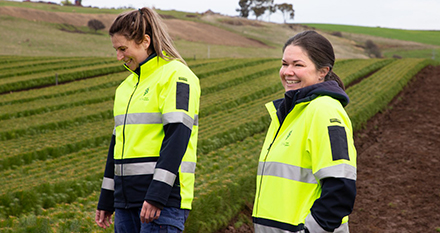A first-of-its-kind Tasmanian program incentivising northern farmers to grow trees on their farms launches today. The ActivAcre Program sees farmers lease part of their less productive land in return for a reliable, annual income. Source: Timberbiz
In addition to increasing the productivity of existing farm activities, the program aims to enhance environmental outcomes such as climate change mitigation and improving biodiversity, soil conservation and water quality.
The program is being managed by Tasmanian-owned plantation and natural assets management company SFM, which currently employs 25 staff and manages over 50,000 hectares of plantation resources across southern Australia.
As part of the initiative, ActivAcre and SFM will plant new trees on under-utilised farming land, to create a regular income for farmers enabling them to share in the benefits of both timber and carbon markets.
Managing Director of SFM, Andrew Morgan said ActivAcre had been co-created with a group of farmers to enable trees to be integrated within the agriculture landscape in a manner that works for them.
“In developing the program with farmers, we identified there was between 10%-20% of unproductive farmland in Tasmania. We need to consider ways to maximise the productivity of all land without negative environmental or social impacts,” he said.
“This requires a level of flexibility that enables landowners to have trees in their landscape that won’t impact other farming pursuits, in fact, it’ll enhance them.
“With climate change and the growing future demand for timber in Australia, we need programs like this which are flexible in nature and strive to partner with landowners and the community – the right tree in the right place for the right reasons.”
Underpinning ActivAcre is Sydney-headquartered New Forests, a global investment manager of nature-based real assets and natural capital strategies who developed the program over a period of two years, using its experience in managing forestry within agricultural landscapes for sustainable production.
New Forests’ Chief Executive Officer David Brand said one of the core objectives of ActivAcre was to partner with farmers and landowners so they can contribute to, and share in the rewards of, a decarbonising economy.
“New Forests vision is to see investment in land use and forestry as key to the transition to a sustainable future, and we see programs like ActivAcre being an integral component of this,” he said.
Cressy farmer Rob Tole has planted more than 50ha of trees on his 560ha Greenvale property and has seen considerable benefits to his land and livestock.
Roughly 12,000 lambs graze on the fourth-generation farmer’s land every year, on top of a diverse mix of crops like peas, beans and chicory seed.
“Our trees provide protection for our livestock which is particularly important during lambing and extreme weather events,” Mr Tole said.
Mr Tole welcomed a program like ActivAcre for farmers looking to diversify their income and have experts take care of the tree planting and monitoring process.
“It turns unproductive ground, which was previously covered in weeds like gorse, into income-producing ground,” he said.
“A program like ActivAcre means landowners can focus on their usual farming practices, diversify their income and see substantial gains to their crops, livestock, soil and water table levels.”
Professor Rod Keenan, Chair of Forest and Ecosystem Science at The University of Melbourne, said a program like ActivAcre that unites industry and farming communities is needed.
Professor Keenan has worked as a research scientist and science advisor in a number of Australian states and with the Australian Government as an advisor on forests and climate change, and has undertaken research across Australia, Canada, Papua New Guinea and South East Asia. He recently led the Next Generation Plantation Investment Research Project, which explored options for increasing trees in rural landscapes.
“By working in active partnership with farmers, the project manager can build the long-term relationships needed to make this investment model successful,” Professor Keenan said.
“Co-design can ensure the trees provide benefits on-farm and more timber resources for local industry.”
ActivAcre Facts
- ActivAcre hopes to see 15,000 hectares of trees planted on Northern Tasmanian farms over a five-year period.
- Hardwood and softwood tree species will be grown and will be site-dependent.
- Landowners can choose two 20-year rotations or one 30-year rotation. • A minimum of a 15-hectare area is required to participate in the program.
Northern Tasmanian farmers are encouraged to express their interest in the program by visiting www.activacre.com.au







